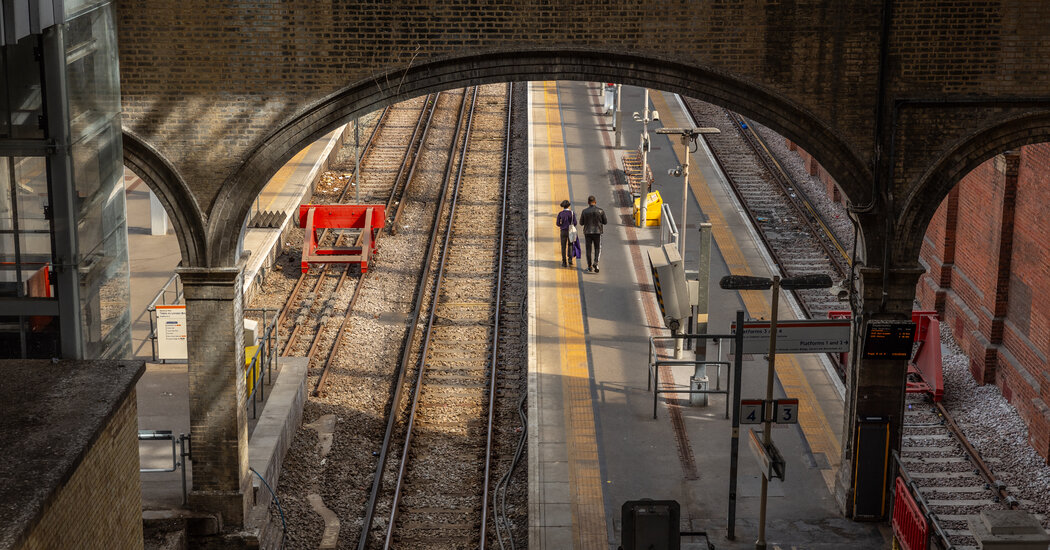In the early 1870s, an émigré painter watched from a railway bridge as a steam engine left a station on the suburban fringes of London. His name was Camille Pissarro, and he was developing a style of plein air painting that would soon be called “Impressionism.”
Pissarro and another émigré, Claude Monet, remained in London for only a few months. In April 1874, they were among the painters who held the first Impressionist exhibition in Paris, the subject of a retrospective that will run until July 14 at the Musée d'Orsay and open on September 8 at the National Gallery of Art in Washington DC.
But London was one of their earliest muses. Monet painted the River Thames and the Palace of Westminster, among other central landmarks, while Pissarro captured suburban scenes where houses and railway tracks were replacing forests and farmland.
I have a special interest in Pissarro's painting of the train because it shows the neighborhood where my wife grew up, in a Victorian house rendered as a “stain” on the impressionist's canvas, as my father-in-law calls it.
The railway, closed in the 1950s, is now a nature trail where our children go in search of blackberries when visiting their grandparents.
On our latest visit, I decided to find out what Pissarro saw on that train and what his early London paintings tell us about Britain's Victorian past. I found that his brushstrokes captured a moment of dramatic urban transformation whose impacts on the shape of the city are still visible today.
My Pissarro project involved long winter walks, trips to museums, a ride on a vintage locomotive, and a bit of investigative journalism surrounding an arcane mystery. My primary guide was my father-in-law, a former “trainspotter” with a fervent interest in railroad history.
'Fog, snow and spring'
A 1990 history of my in-laws' area describes the old railroad as “lost.” But, like other places Pissarro painted in south-east London, the site where the tracks once ran was not difficult to find. I could see it through a bedroom window, just beyond the camellia and winter jasmine.
Pissarro, a Danish citizen fleeing a Paris suburb during the Franco-Prussian War, was used to being an outsider. He was born on the Caribbean island of St. Thomas to Jewish parents of French origin and moved to Paris in 1855 after some years in Caracas.
But he was not completely isolated when he arrived in London with his partner, Julie Vellay, and their two young children in December 1870. They stayed with relatives in the south-eastern suburb of Norwood, and he socialized with Monet and other émigré artists in a period of free time. central café run by a French wine merchant.
Pissarro, 40, was frustrated by his lack of commercial success and his family was homesick. Vellay described the English language as a “succession of curious noises.”
London, however, was not all bad for them. It was there that Pissarro and Vellay married; where he met Paul Durand-Ruel, an art dealer who would sell his work for decades; and where he painted several canvases in his formative Impressionist style.
“Monet and I were very enthusiastic about London landscapes,” he later wrote. “Monet worked in the parks, while I, living in Lower Norwood, then a charming suburb, studied the effects of fog, snow and spring.”
Time travel
Pissarro lived near the Crystal Palace, a glass-domed exhibition space that epitomized Victorian Britain’s sense of modernity and had moved from Hyde Park to south-east London in the 1850s. But the painter, who worked outdoors in wooden clogs, was more interested in the suburban scenes that unfolded around the corner.
One of Pissarro's early London paintings, “Fox Hill, Upper Norwood,” shows figures walking down a snow-dusted residential street. When my father-in-law, Alec, took me there one windy December morning, we noticed that many of the same houses were still there.
The winter sky was the same dappled gray that Pissarro loved to paint (and that my long-time expat wife Cat loves to hate). I was struck by the way his silent canvas still captured the area’s rolling hills and refracted the sunlight.
Then we noticed two people wandering down the street holding a print of the same painting. What were the odds? It turned out that they were also Pissarro groupies, searching the present for clues about the past.
“It’s just like time travel,” one of them, Libby Watson, told me. “It’s the closest you can get, isn’t it? — looking at old buildings and imagining yourself there.”
A city “in bulk”
When Pissarro arrived in London, the city was still expanding alongside the new railways. The railway line he painted in 1871 had opened in 1865 to serve new suburban commuters, as well as tourists traveling to the Crystal Palace from Victoria Station, near Buckingham Palace.
In 1866 or 1867, my in-laws' house was built next to the line on a road that had been a path through fields near the village of Dulwich, whose name comes from an Old English word for “the meadow where dill grows”. The road was in Forest Hill, a new suburb that, like Norwood, took its name from the Great North Wood, an ancient forest that was largely felled as London pushed south in the 19th century.
Not everyone liked the speed of change. The Victorian art critic and social philosopher John Ruskin, who lived in the Dulwich area, complained that fields near his home had been dug up for building sites or cut up by the “wild crossings and competition” of the railways.
“No linguistic term known to me is sufficient to describe the forms of filth and the modes of ruin,” wrote Ruskin, who left London in 1872 for the English Lake District.
London's expansion in the 19th century was not well organized but “haphazard”, as my father-in-law says, and fueled by railway rivalries. The line painted by Pissarro was managed by a company that competed with a nearby company for passengers. Both were run by “belligerent characters” who built unnecessary tracks for the sake of competing, according to railway historian Christian Wolmar.
The competition “has resulted in a complex and underinvested network that still causes commuters discomfort today,” Wolmar wrote in “Fire and Steam,” his 2007 history of Britain’s railways. And as any south-east Londoner will tell you, train service in the area remains notoriously patchy.
But for a visiting 19th-century Impressionist, it must have been fascinating to watch a gigantic city devour the countryside in real time.
On the trail
“Lordship Lane Station, Dulwich,” Pissarro's 1871 railway painting, shows a black engine belching smoke as it approaches the viewer on tracks crossing empty fields. A railway signal – a metal or wooden device whose positioning indicated whether a train driver should stop or start – hovers overhead in a horizontal position.
Today the scene is almost unrecognizable. The railway line closed in 1954, almost 18 years after the Crystal Palace fire. Lordship Lane station was later demolished and a local bus route was extended to cover the former railway route.
Homes now sit on what was once open land, and the Pissarro-painted railway bridge sits in a nature reserve (and is temporarily closed for renovations).
The strip of land where the train tracks that ran in front of my in-laws’ house once ran has been transformed into a nature trail.
As for the canvas, it now hangs in the Courtauld Gallery in central London. When we visited in December, I was so busy trying to keep our children from destroying priceless works of art that I didn't have much opportunity to study it.
But we got a taste of Britain's railway heritage at other points on our journey. One day we took our locomotive-obsessed boys on a steam train ride along the Bluebell Railway, a historic line outside London. Those tracks were once owned by a railway company that financed the move of the Crystal Palace to south-east London after the Great Exhibition of 1851.
The children also played on trains at the London Transport Museum, where an exhibit informed us that the “unstructured” growth of the 19th century had transformed the city.
“Lordship Lane” highlights the drama of that transition because Pissarro's train tracks divide a still-rural piece of land from a newly suburbanized one, Karen Serres, the senior curator of paintings at the Courtauld, told me when I called for a chat.
And unlike many other Pissarro works, “Lordship Lane” does not show people. When Courtauld staff X-rayed the canvas in 2007, they found that a human figure had been painted in the corner of an early version, then painted over.
The train, then, is the main subject. And you can't avoid it because it's coming straight at you.
The signal in question
“Lordship Lane” is often compared to “Rain, Steam and Speed,” an 1844 landscape painting by J.M.W. Turner. Pissarro and other French Impressionists openly admired English artists, whose works they saw in London museums. Art historians have long debated the extent to which the Impressionists were influenced by British painters.
I don't have a strong opinion on the matter. But in London I was very interested in resolving another, even more arcane, historical debate.
Specifically, I was told that “Lordship Lane” is the painting the Courtauld receives the most complaints about. Among other things, critics apparently argue that Pissarro's Victorian train sign should have been vertical for “go,” not horizontal for “stop.”
Dr Serres told me that what I had heard was correct. Over the years, he had changed the museum's description of the painting after railway enthusiasts pointed out errors, including the original title of “Penge Station, Upper Norwood”.
But he had never known what to make of suggestions that the sign should be vertical for “away” because the train appeared to be stopped at the station. His impression was that the train was “slightly beyond” the platform and that he had already received the signal to proceed. On the other hand, other details in the painting, including the station and train smoke, didn't seem particularly accurate.
“It's very difficult to know how completely accurate these things are, and in fact that wasn't the point,” he said. “It was to create a beautiful composition.”
My father-in-law said he tended to think the signal was correct because the train appeared to have already passed the station. But he wasn't entirely sure.
So I called Mr. Wolmar, the author of “Fire and Steam,” who later emailed me to say he agreed.
“The train has now passed the signal, so it will have returned to its default position, which is horizontal,” he wrote.





